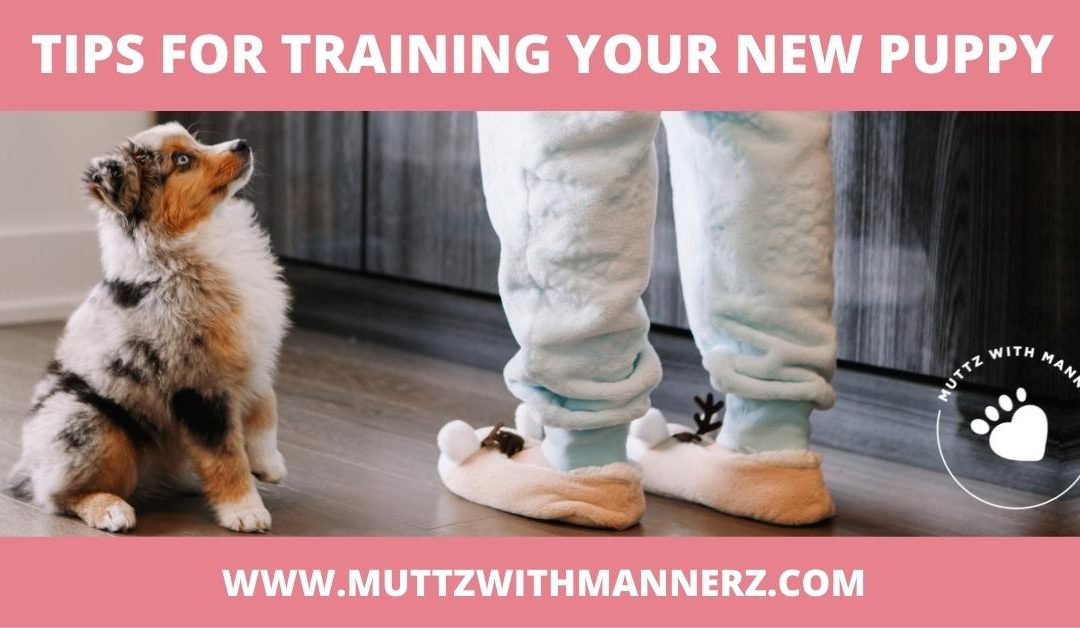You’ve just brought your new puppy home and are excited to start training, but you are wondering “When do I start?” You start the moment they enter your home! Puppies start learning from birth and by 8 weeks when they go to their forever home, they are well on their way. In the beginning, keep it simple – start with house training and get them familiar with their new family and routine. How do I start the training? 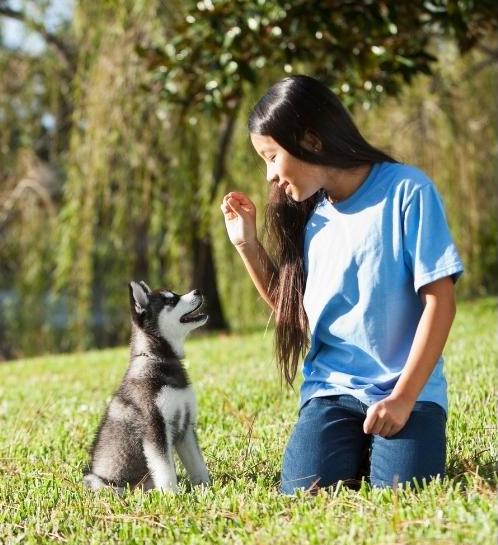 When training a puppy be positive and gentle. Keep training sessions short and sweet as your puppy’s attention span is limited. Puppies can be taught different commands by using a lure, treat or toy to assist with training and motivate your puppy. Provided the lure appeals to them, the puppy can be encouraged to give the desired response. By showing the puppy the reward you lure them to do it. Repeat this a few times then voice the command i.e. “sit”. Treats entice the dog to follow their nose into the position/command that you want, typically “sit”, “down,” “stand,” and “stay. For example, food held up over the puppy’s nose and moved slowly backward above their head should get a ‘sit’ response; food drawn down to the floor should get a ‘down’ position; food brought back up should get a ‘stand’ position, and food held at your thigh as you walk should get the puppy to ‘heel or ‘follow’. The basic steps:
When training a puppy be positive and gentle. Keep training sessions short and sweet as your puppy’s attention span is limited. Puppies can be taught different commands by using a lure, treat or toy to assist with training and motivate your puppy. Provided the lure appeals to them, the puppy can be encouraged to give the desired response. By showing the puppy the reward you lure them to do it. Repeat this a few times then voice the command i.e. “sit”. Treats entice the dog to follow their nose into the position/command that you want, typically “sit”, “down,” “stand,” and “stay. For example, food held up over the puppy’s nose and moved slowly backward above their head should get a ‘sit’ response; food drawn down to the floor should get a ‘down’ position; food brought back up should get a ‘stand’ position, and food held at your thigh as you walk should get the puppy to ‘heel or ‘follow’. The basic steps:
- Begin by practicing without the word command, this helps them understand the behaviour.
- Next, combine a command word with each action to give it a name.
- Now mark the behaviour when they do it immediately with a “Yes”. This reinforces that they did what you want.
- Give a reward for each appropriate response.
After some repetition, your puppy should soon learn the meaning of each command. Verbal marking “Yes!” is key to the success How often should I give the command? Ideally, you should give the command word once. Once the puppy has performed the task, add in verbal praise (the marking) “good dog or yes!” to reinforce the behaviour. If your puppy doesn’t immediately obey on the first command, then pause and try something else. Patience is essential to the learning process. If you repeat the command without them doing the action your puppy will learn that several repetitions are acceptable before they respond. 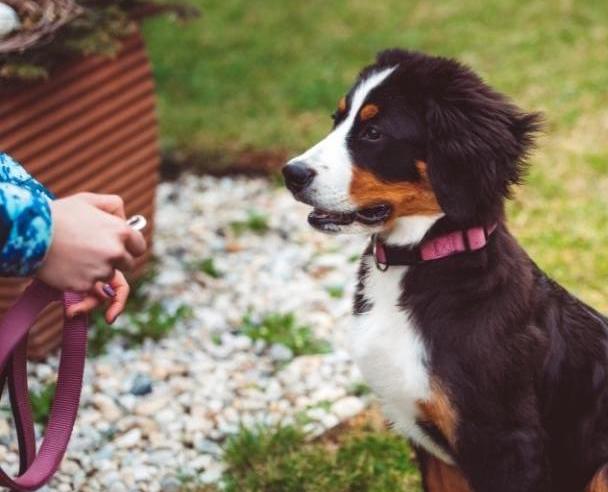 We suggest having them on leash while training, so they stay with you and don’t run off. Remember that, in the beginning, your puppy does not know the meaning of the word. You could just as easily teach your puppy to sit with the word “car” or any other word. The key is to associate the word, in this case – “sit,” with the action of placing their butt on the floor. Consistency is also key, use the same command word each time and keep it simple. A singular word is best. When and how should I phase out the lure and food rewards? Once your puppy understands the command and is doing it consistently when you ask, you can then start to wean out the lure. At first, you are going to let the puppy see the treat so you have their attention and can use it to guide them into position. As your puppy begins to do the command consistently you can remove the food by hiding it in your hand. Say the command and praise them with a pat or “good dog”. Give the treat perhaps every 2 or 3 times. Next, you can begin to vary the frequency, giving praise; marking with a “yes” and perhaps patting each time, but treating randomly – every 3 or 4 times. In time, the puppy should respond to just the command. Over time, the words “yes” or “good dog” and the affectionate pat become the reinforcers. Because it’s been paired with a treat it takes on more meaning and reinforces the training.
We suggest having them on leash while training, so they stay with you and don’t run off. Remember that, in the beginning, your puppy does not know the meaning of the word. You could just as easily teach your puppy to sit with the word “car” or any other word. The key is to associate the word, in this case – “sit,” with the action of placing their butt on the floor. Consistency is also key, use the same command word each time and keep it simple. A singular word is best. When and how should I phase out the lure and food rewards? Once your puppy understands the command and is doing it consistently when you ask, you can then start to wean out the lure. At first, you are going to let the puppy see the treat so you have their attention and can use it to guide them into position. As your puppy begins to do the command consistently you can remove the food by hiding it in your hand. Say the command and praise them with a pat or “good dog”. Give the treat perhaps every 2 or 3 times. Next, you can begin to vary the frequency, giving praise; marking with a “yes” and perhaps patting each time, but treating randomly – every 3 or 4 times. In time, the puppy should respond to just the command. Over time, the words “yes” or “good dog” and the affectionate pat become the reinforcers. Because it’s been paired with a treat it takes on more meaning and reinforces the training. 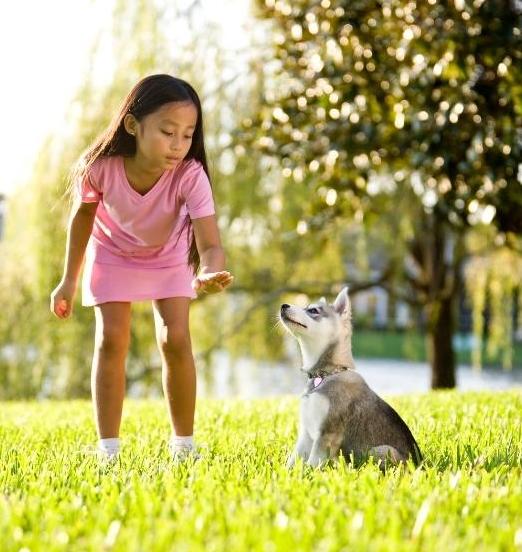 It is key to remember is that this reinforcement is needed to prepare for when you don’t have a treat with you. Treat training is beneficial, but your goal is that your puppy will perform a task without it in the future. Their reward is your praise and affection. Treats can be used throughout their life just not every time. Using hand signals combined with the word command can also help give your pup another communication tool. Holding your palm upwards for a sit, pointing to the ground for a down, or having your hand at your thigh or side for the heel commands are common examples. When starting your training use a non-distracting environment like a quiet room versus outdoors. Over time, however, begin asking your puppy to perform the commands in different locations and with distractions such as noise. Rewards should be saved for these training sessions. How much time should I spend training my puppy every day? Training should be part of your puppy’s daily routine. When you feed them, have them sit – when you walk them, have them sit. Have them sit before exiting the door, and at every street crossing. Add in short 5-minute focused sessions throughout the day in different places. You can get creative and add in some tricks. A good goal would be to train your puppy for at least 15 minutes per day. With each command you are teaching, practice it 3-5 times then take a break. Your puppy can get bored easily and if they are not getting it, it’s good to take a break and come back to it when both of you are able to focus, as training can be frustrating. Include all family members in the training process, having everyone involved ensures your puppy performs for everyone. Do group classes help? Pet owners who are beginners at training can begin with these simple steps. It takes repetition, time, and perseverance for the puppy to predictably and reliably respond to commands in a variety of situations. Consider group classes to help build on the training you’ve started at home.
It is key to remember is that this reinforcement is needed to prepare for when you don’t have a treat with you. Treat training is beneficial, but your goal is that your puppy will perform a task without it in the future. Their reward is your praise and affection. Treats can be used throughout their life just not every time. Using hand signals combined with the word command can also help give your pup another communication tool. Holding your palm upwards for a sit, pointing to the ground for a down, or having your hand at your thigh or side for the heel commands are common examples. When starting your training use a non-distracting environment like a quiet room versus outdoors. Over time, however, begin asking your puppy to perform the commands in different locations and with distractions such as noise. Rewards should be saved for these training sessions. How much time should I spend training my puppy every day? Training should be part of your puppy’s daily routine. When you feed them, have them sit – when you walk them, have them sit. Have them sit before exiting the door, and at every street crossing. Add in short 5-minute focused sessions throughout the day in different places. You can get creative and add in some tricks. A good goal would be to train your puppy for at least 15 minutes per day. With each command you are teaching, practice it 3-5 times then take a break. Your puppy can get bored easily and if they are not getting it, it’s good to take a break and come back to it when both of you are able to focus, as training can be frustrating. Include all family members in the training process, having everyone involved ensures your puppy performs for everyone. Do group classes help? Pet owners who are beginners at training can begin with these simple steps. It takes repetition, time, and perseverance for the puppy to predictably and reliably respond to commands in a variety of situations. Consider group classes to help build on the training you’ve started at home. 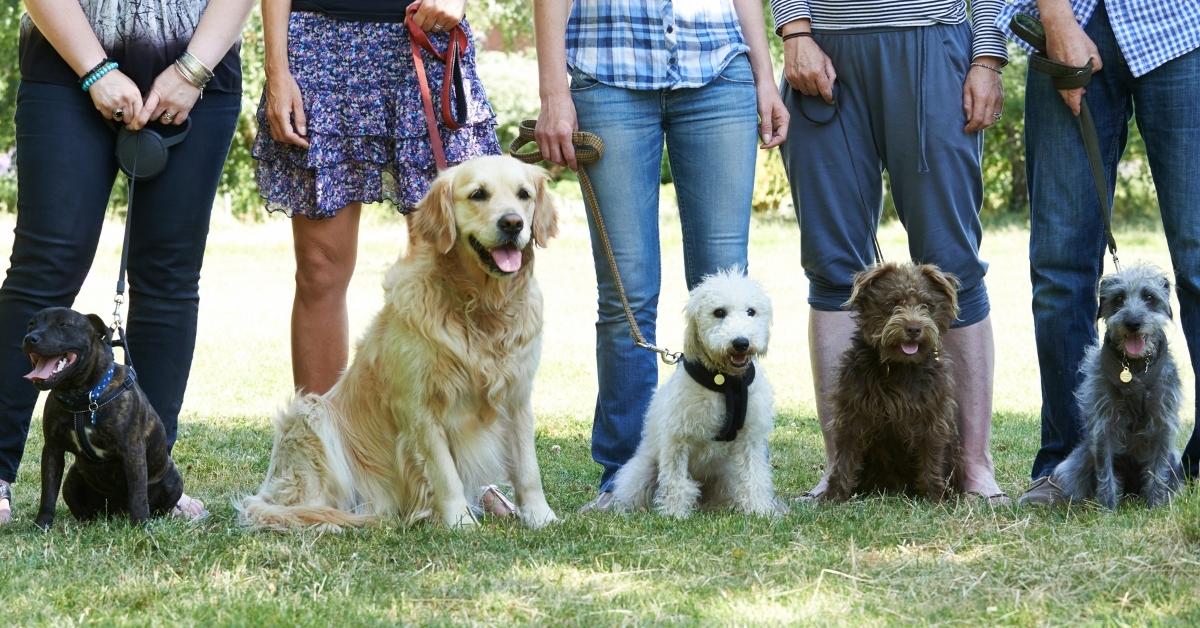 A group class serves many functions. Trainers can demonstrate techniques and help guide you through the steps in training. They can help advise you on puppy training problems and advance your training to exercises that are more difficult. Having your puppy learn in a group situation provides them with real-life distractions. And, considering human nature, the pet owner who takes their dog to a puppy class feels accountable as they are asked to practice throughout the week so they do not want to fall behind by the next class. Finally, a training class is a good place to meet other new puppy owners and see how other puppies behave. Group training classes for young puppies is a great way to socialize your new puppy to a variety of people, dogs, and other stimuli in a controlled environment. In addition, you will learn how to prevent or deal with common problems such as nipping, jumping, and pulling on leash. As an added benefit – your puppy can make some new fur friends. The primary socialization period for dogs ends by 12 weeks, puppy socialization classes are most valuable for puppies 8 weeks of age and older. If all puppies in the class have had initial vaccinations, are healthy and parasite-free, the health risks are low, and the potential benefits are huge.
A group class serves many functions. Trainers can demonstrate techniques and help guide you through the steps in training. They can help advise you on puppy training problems and advance your training to exercises that are more difficult. Having your puppy learn in a group situation provides them with real-life distractions. And, considering human nature, the pet owner who takes their dog to a puppy class feels accountable as they are asked to practice throughout the week so they do not want to fall behind by the next class. Finally, a training class is a good place to meet other new puppy owners and see how other puppies behave. Group training classes for young puppies is a great way to socialize your new puppy to a variety of people, dogs, and other stimuli in a controlled environment. In addition, you will learn how to prevent or deal with common problems such as nipping, jumping, and pulling on leash. As an added benefit – your puppy can make some new fur friends. The primary socialization period for dogs ends by 12 weeks, puppy socialization classes are most valuable for puppies 8 weeks of age and older. If all puppies in the class have had initial vaccinations, are healthy and parasite-free, the health risks are low, and the potential benefits are huge.
Check out our Muttz with Mannerz™ Canine Academy training classes at https://www.muttzwithmannerz.com/dog-training/classes.
The time you spend training your puppy now will pay off when you have an adult dog. To have a well-trained dog, you need to be committed to reinforcing the training tasks on nearly a daily basis for the first year of your puppy’s life. The more you teach and supervise your puppy, the less opportunity it will have to engage in improper behaviors, and well-mannered they will be.

